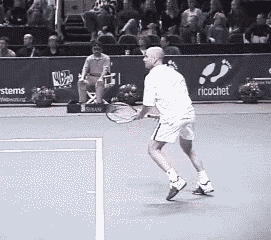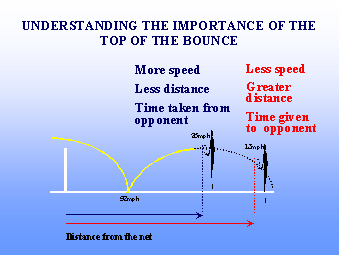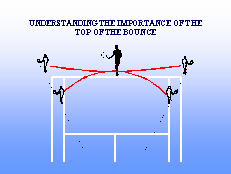
Advantages of Taking the Ball Early
Television analysts often comment about taking the ball early and cutting away an opponent's time. Interestingly, these comments occur more often in matches with players who move forward (Dent, Henman, and Federer) than in matches where defensive players slug it out from behind the baseline.
But as the power game becomes more of a staple of professional tennis, we see less of the attacking style of a John McEnroe, who was able to rush his opponent without hitting the ball hard all the time. Stefan Edberg, Patrick Rafter, Pete Sampras, all were known for their eagerness to move forward, take the ball early if not on the rise, and make something happen.
In a similar vein, terms such as “top of the bounce” and “take it on” describe a similar situation where the player moves forward and hits a groundstroke as the ball ascends, or as the ball peaks. However, I'm not always certain every player knows exactly what this means and, importantly, why exactly it is so helpful.
 Of equal importance, I am not sure if every player has the skill set that enables them to move forward and play the ball early, for the timing in this technique is far different than what occurs when one waits on the ball and allows the ball to descend.
Of equal importance, I am not sure if every player has the skill set that enables them to move forward and play the ball early, for the timing in this technique is far different than what occurs when one waits on the ball and allows the ball to descend.
The following advantages are gained by taking a ball early (at the top of the bounce) given the general assumption that a ball loses half its speed from the time it bounces to the top of the bounce and another half if it drops half its height again.
Advantage 1: Striking the ball at the top of the bounce gives you maximum ball speed with good control to use against an opponent. Using greater speed by half-volleying is difficult to control and letting the ball drop gives away too much speed.
Advantage 2: If you strike a falling ball, not only is the ball travelling slower but you have to give up ground to give the ball the time to travel further and drop.
Advantage 3: This is the time that it takes the ball to travel from the top of the bounce to a dropped position and back again after the strike – split seconds that compound shot after shot.
Advantage 4:The top of the bounce generally is as high if not higher than the level of the net, so balls contacted at this height more easily cross the net than balls that are contacted below the level of the net.
The diagram below shows that you have more speed to use against your opponent (26mph) than when letting the ball drop (13mph). You also give away about 1-2 yards in distance and lose the time that it takes the ball to travel from the top of the bounce to the falling contact point.
 A player's ability to time and position himself/herself to take the ball early when appropriate is possibly the single most important separator in the different levels of play.
A player's ability to time and position himself/herself to take the ball early when appropriate is possibly the single most important separator in the different levels of play.
The very best in the world are almost balletic in their footwork and artistic in their use of spin and pace off an early strike. Great approachers of the net, especially off the slice backhand are masters of using the pace of the ball against opponents – Edberg, Rafter, Henman, Rusedski, and Novotna are a few of the recent masters of slice backhand approach.
One of the major changes in tennis is the growing exploitation of taking second serve returns extremely early by hitting over the ball rather than as a slice approach. Agassi, Safin, and Federer are masters but in general, all the best players in the world clearly understand how to “take time away” from an opponent and more importantly can execute at the right moments. It is this ability to speed up a point without resorting to pure pace that allows top players to suddenly control a point from inside the baseline. This opens up attacking options and the opportunity to sneak forward.
Drill
An excellent drill to begin to gain the feel of an early ball is to rally at ¾ pace with one player following each shot with a step behind each shot commonly known as “moving through the ball”. The lower pace allows for time to feel the sensation of taking a ball early.
The drill requires one player to rally from behind the baseline hitting at ¾ pace down the middle of the court. The other player takes each ball on the rise and follows his stroke with a good solid step behind the ball. The ¾ pace enables the feeder to be very accurate and the person practicing the top of the bounce contact can do it expertly without rushing back to recover. As confidence and timing grows the pace tends to automatically increase.
Another aspect in performing this drill at ¾ pace is that players learn that taking a ball early does not necessarily mean swinging faster. It is one thing to move up the court to cut down an opponent's time or to hit on the rise putting pressure on an opponent but it is another thing to swing faster and earlier than is necessary.
The net result of taking the ball at the top of the bounce:
 1. You save the fraction of a second it would take for the ball to travel from the top of the bounce to the half drop and back again.
1. You save the fraction of a second it would take for the ball to travel from the top of the bounce to the half drop and back again.
2. You have more ball speed to play with.
3. You are physically closer to your opponent.
4. The diagram on the right shows how much court a player may lose by letting a ball drop when moving side to side. If the ball is travelling crosscourt a player also has further to run if hitting a falling ball.
So if you are “game” to try and take the ball earlier than usual, consider the following. The single best opportunity to move forward and “take it on,” as the Brit's might say, is when the opponent hits a short and relatively simple ball. When might this occur? Well perhaps in a rally, perhaps if your own shot was deep and well placed causing a short reply.
But a simpler scenario, and one that can be practiced on a daily basis, is to move forward and take the return of the second serve on the rise – each and every time. The second serve is by definition a short shot, generally hit with less pace and placement (unless you are playing an outstanding player) and if you want to apply pressure, take their time away and play the ball suddenly – this is as good an opportunity as one gets. Go for it!
So if you are now willing to “take it on”, you understand the benefits, the rebound velocities, and the likely scenarios as to when you might move forward to take the ball early, here are some concluding tips about how the tempo of such a stroke feels
Prepare just slightly earlier than usual – this does not mean to instantly take the racquet back, but in this version you are trying to rush the opponent without necessarily rushing your own shot. In general, this stroke is shorter both on backswing and follow through than one used behind the baseline, almost a blocking stroke.
When playing behind the baseline the opposite baseline can be as much as 85 feet away (the court is 78 feet long) but when inside the baseline you have less court to work with, keeping the ball relatively low across the net is a requirement. And finally come to enjoy the feeling where you have as much time as you want, but the opponent feels rushed. It is all about time in this scenario and you are “stealing” theirs.
Pictures used in this article are courtesy of TennisOne

